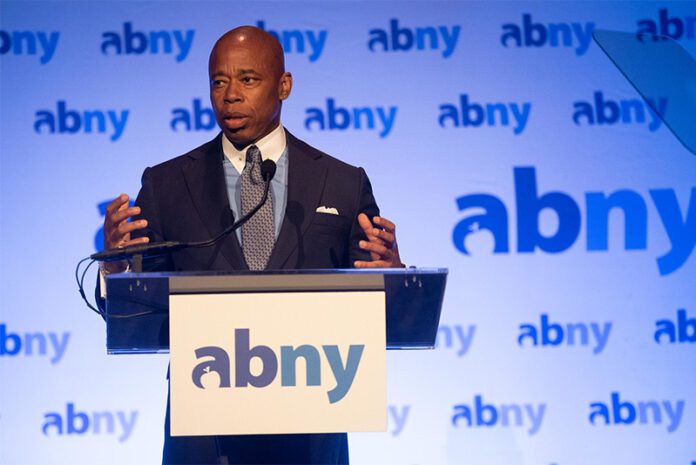In NYC Mayor Eric Adams’ most recent $99.7 billion budget proposal, he carved out $5 billion of funding for affordable housing. When speaking on the investment, Adams said that the money would “make critical repairs at NYCHA, subsidize those who need help staying in their existing homes, and build more deeply affordable housing for the entire city.”
On the first of June, Adams took his affordable housing agenda a step further, offering a blueprint of where NYC’s affordable housing units could go. The Mayor’s “City of Yes Plan,” which also focuses on sustainability and small business investment, aims to counter NIMBYism, otherwise known as “Not In My Back Yard”. Proponents of NIMBYism are typically against large-scale or even smaller-scale developments in their neighborhoods due to concerns about local character, increased crime, excessive traffic, noise, environmental pollution, and more. An example of this would be the recent claims against the One45 development in Harlem claiming it would promote gentrification.
The “City of Yes” plan aims to turn NYC into a more equitable, inclusive city with updated zoning regulations. The three new citywide zoning amendments include Zoning for Economic Opportunity, Zoning for Housing Opportunity, and Zoning for Zero Carbon. The zoning will focus its sights on emerging employment centers and commercial corridors in all five city boroughs. According to the mayor’s plan, the new zoning regulations will start in the Bronx, the borough with the highest poverty rate.
“We are going to turn New York into a ‘City of Yes’ — yes in my backyard, yes on my block, yes in my neighborhood,” said Mayor Adams. “These proposals focused on economic recovery, affordable housing, and sustainability will remove red tape for small businesses, expand housing opportunities in every neighborhood, and accelerate the transition to our energy future”.
How Will the Updated Zoning Affect Housing Production?
The city’s Zoning for Housing Opportunity amendment will incentivize more housing construction in neighborhoods within all five boroughs. Although the portion of the plan available to the public is devoid of many details, the mayor’s press release touches on a few main ways they plan on reaching this goal.
First, the administration wants to widen the acceptable variety of housing types and sizes, including studios, to accommodate a wider range of families and households. This may mean allowing studios or one-bedroom apartments in neighborhoods primarily zoned for single-family use. In practice, this change would allow a greater variety of people to live in neighborhoods that were previously only reserved for households that could afford a larger home.
The plan also calls for expanding the eligible floor area ratio for affordable and supportive housing, allowing eligible, larger households to live under one roof. This sort of policy is already allowed for affordable housing for seniors.
Another proposal is reducing overreaching parking requirements for buildings that don’t need it. Many zoning laws include mandatory minimum parking requirements, but with land at a premium in NYC, surface parking lots are a major waste of space. The city hopes that by reducing parking requirements, more parking lots can turn into future homes, both affordable and market rate.
Lastly, the plan calls for simplifying the process of converting underutilized commercial buildings into homes. Not all commercial buildings can realistically convert into homes. For example, developers won’t be able to feasibly redevelop most vacant office buildings into housing without a substantial financial subsidy, but other types of commercial properties are easier to convert.
NY Governor Hochul recently released a plan that would turn more underutilized hotel space into affordable housing. The new law allows Class B hotels that meet certain criteria and are within 400 feet of districts that permit residential use, to apply their existing certificates of occupancy to become permanent residential spaces. Eligible Class B hotels can provide permanent housing if they receive state funding or enter into an agreement with the City’s government.
Will the Updated Zoning Reduce NYC’s Housing Shortage?
Critics argue that changing zoning laws to specifically allow more affordable housing units is crucial. Otherwise, new affordable housing units aren’t likely. For example, the former Long Island College Hospital site in Cobble Hill, Brooklyn didn’t go through rezoning to allow for a larger project with affordable housing, so it ended up turning into a smaller luxury housing project instead.
The most recent citywide rezoning aimed at increasing and preserving affordable housing was the 2016 passing of the mandatory inclusionary housing program (MIH), which built on the existing inclusionary housing program (IHP). It was meant to promote affordable housing construction in three main zoning districts:
- R10 zoning districts, which are outside of IHP areas and were formed in 1987 along with the original Inclusionary Housing Program. R10 was expanded in 2005 with the passing of IHP “Designated Areas”. Affordable housing in these districts isn’t mandatory.
- IHP districts also don’t mandate affordable housing creation, but merely encourage and incentivize it.
- Mandatory inclusionary housing (MIH) zones are different from IHP, as it often mandates affordable housing. In MIH districts, affordable housing is mandatory for residential developments, enlargements, or conversions. In select circumstances, a developer can pay into an affordable housing fund if no affordable units were built. Affordable units are not required for smaller, new residential developments, enlargements, or conversions that are less than 12,500 square feet, and contain fewer than 10 residential units.
The city is clearly on the right path by further updating its citywide zoning for more affordable housing production, but more work is needed to address a growing affordability problem in one of America’s most expensive cities.
Tyler graduated from Virginia Commonwealth University in 2017 with a Bachelor's degree in Urban and Regional Studies. Currently based in Los Angeles, he works as a freelance content writer and copywriter for companies in real estate, property management, and similar industries. Tyler's main professional passion is writing about critical issues affecting big and small cities alike, including housing affordability, homelessness, inequality, and transportation. When he isn't working, he usually plans his next road trip or explores new neighborhoods and hiking trails.



